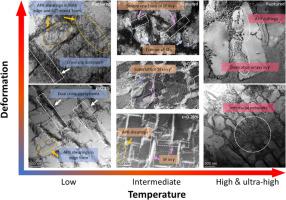当前位置:
X-MOL 学术
›
J. Mater. Sci. Technol.
›
论文详情
Our official English website, www.x-mol.net, welcomes your feedback! (Note: you will need to create a separate account there.)
Full-operating-temperature tensile mechanisms of [111] oriented single-crystal superalloy: New intermediate temperature toughening behavior against ductility losing
Journal of Materials Science & Technology ( IF 11.2 ) Pub Date : 2024-06-28 , DOI: 10.1016/j.jmst.2024.06.020 Yuanhang Gao , Yi Ru , Yao Gao , Xuechen Xia , Zhiyong Zhong , Zhiyue Shi , Rongguang Jia , Bin Hu , Haigen Zhao , Wenyue Zhao , Yanling Pei , Shusuo Li , Shengkai Gong
Journal of Materials Science & Technology ( IF 11.2 ) Pub Date : 2024-06-28 , DOI: 10.1016/j.jmst.2024.06.020 Yuanhang Gao , Yi Ru , Yao Gao , Xuechen Xia , Zhiyong Zhong , Zhiyue Shi , Rongguang Jia , Bin Hu , Haigen Zhao , Wenyue Zhao , Yanling Pei , Shusuo Li , Shengkai Gong

|
Single crystal (SX) superalloys are required for full-operating-temperature mechanical properties. However, the quest for intermediate temperature (IT) resistance often encounters a perplexing phenomenon: anomalous yielding behavior coupled with an unexpected loss of ductility. This study delved into the tensile behavior of a [111]-oriented SX superalloy from room temperature (RT) to 1150 °C, uncovering temperature-dependent tensile mechanisms where the interplay among phases and deferent defects governs plastic deformation. Desirable high strength-ductility properties were observed at IT, showcasing comparable strength with increased ductility. Microstructural evidences show that the primary strengthening effects stem from coupled interface boundary strengthening and anti-phase boundary (APB) strengthening, while the plasticity arises from planer defects transitioning from the stacking fault (SF) within γ phase at small strains, to superlattice SFs, ultimately to the erasure of superlattice SFs, leaving cutting dislocation pairs in γʹ phase. Energy analysis of APB and SF, along with adherence to Schmid laws, reinforce the plausibility of such intricate defect interactions. The strength-ductility balance can be ascribed to the collective effect of preferentially generated dislocations and prompt formation of SF. This strategy of sequential defects’ competition provides a new route for solving the strength-ductility trade-off of alloys.
中文翻译:

[111]取向单晶高温合金的全工作温度拉伸机制:防止延展性损失的新中温增韧行为
单晶(SX)高温合金需要在全工作温度下具有机械性能。然而,对中温 (IT) 耐受性的追求经常会遇到令人困惑的现象:异常的屈服行为加上意外的延展性损失。这项研究深入研究了 [111] 取向 SX 高温合金从室温 (RT) 到 1150 °C 的拉伸行为,揭示了与温度相关的拉伸机制,其中相和不同缺陷之间的相互作用控制着塑性变形。在 IT 中观察到了理想的高强度-延展性,显示出可比的强度和增加的延展性。微观结构证据表明,主要强化效应源于耦合界面边界强化和反相边界(APB)强化,而塑性则源自小应变下γ相内的堆垛层错(SF)向超晶格SF的平面缺陷转变,最终消除超晶格SF,留下γʹ相的切削位错对。 APB 和 SF 的能量分析以及对施密德定律的遵守,增强了这种复杂缺陷相互作用的合理性。强度-延展性平衡可归因于优先产生位错和迅速形成 SF 的集体效应。这种连续缺陷竞争策略为解决合金的强度-延展性权衡提供了新途径。
更新日期:2024-06-28
中文翻译:

[111]取向单晶高温合金的全工作温度拉伸机制:防止延展性损失的新中温增韧行为
单晶(SX)高温合金需要在全工作温度下具有机械性能。然而,对中温 (IT) 耐受性的追求经常会遇到令人困惑的现象:异常的屈服行为加上意外的延展性损失。这项研究深入研究了 [111] 取向 SX 高温合金从室温 (RT) 到 1150 °C 的拉伸行为,揭示了与温度相关的拉伸机制,其中相和不同缺陷之间的相互作用控制着塑性变形。在 IT 中观察到了理想的高强度-延展性,显示出可比的强度和增加的延展性。微观结构证据表明,主要强化效应源于耦合界面边界强化和反相边界(APB)强化,而塑性则源自小应变下γ相内的堆垛层错(SF)向超晶格SF的平面缺陷转变,最终消除超晶格SF,留下γʹ相的切削位错对。 APB 和 SF 的能量分析以及对施密德定律的遵守,增强了这种复杂缺陷相互作用的合理性。强度-延展性平衡可归因于优先产生位错和迅速形成 SF 的集体效应。这种连续缺陷竞争策略为解决合金的强度-延展性权衡提供了新途径。
















































 京公网安备 11010802027423号
京公网安备 11010802027423号